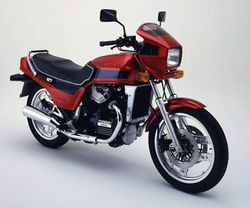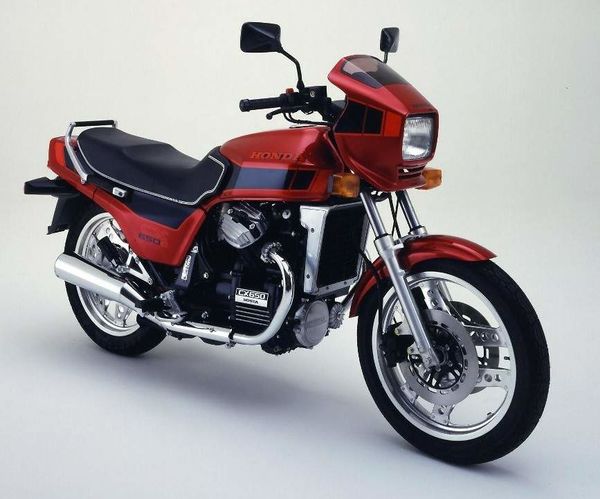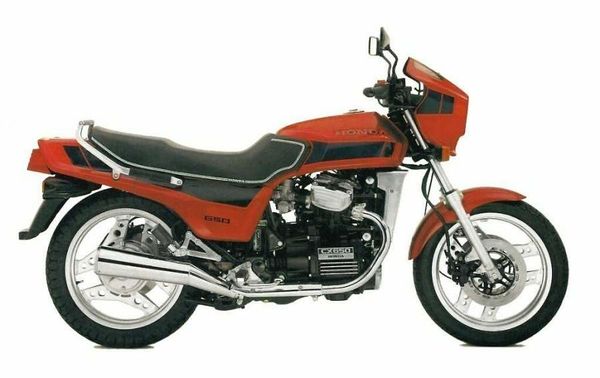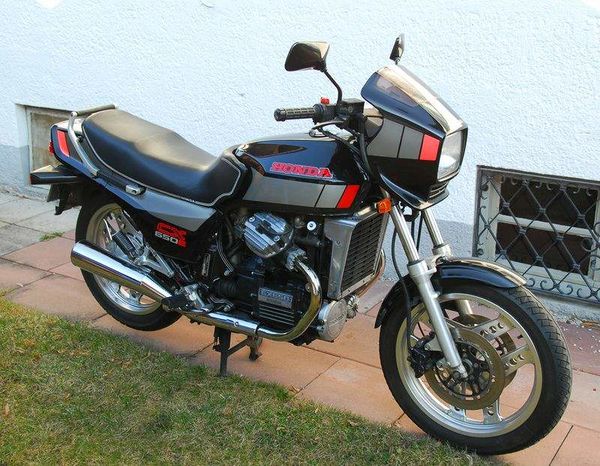Honda CX650ED Euro Sport
 |
|
| Honda CX650ED Euro Sport | |
| Manufacturer | |
|---|---|
| Production | 1985- |
| Class | Standard |
| Engine | Four stroke, longitudinal 800 V-twin cylinder, camshaft nestles at the base of the V between the cylinders. ,OHV, 4 valves per cylinder operated by pushrods |
| Compression ratio | 9.8:1 |
| Top Speed | 116 mph |
| Ignition | CDI |
| Transmission | 5 Speed |
| Suspension | Front: Air assisted telescopic forks Rear: Pro-link, air adjustable preload |
| Brakes | Front: 2x 280mm discs Rear: Single 280mm disc |
| Front Tire | 100/90-18 |
| Rear Tire | 120/90-18 |
| Weight | 227 kg / 500.4 lbs (dry), 235.0 kg / 518.1 lbs (wet) |
| Recommended Oil | Honda GN4 10W-40 |
| Fuel Capacity | 19 Liters / 5.0 US gal |
| Manuals | Service Manual |
It could reach a top speed of 116 mph.
Engine[edit | edit source]
The engine was a Liquid cooled cooled Four stroke, longitudinal 800 V-twin cylinder, camshaft nestles at the base of the V between the cylinders. ,OHV, 4 valves per cylinder operated by pushrods. The engine featured a 9.8:1 compression ratio.
Drive[edit | edit source]
Power was moderated via the Wet, multi-plate, 5-speed.
Chassis[edit | edit source]
It came with a 100/90-18 front tire and a 120/90-18 rear tire. Stopping was achieved via 2x 280mm discs in the front and a Single 280mm disc in the rear. The front suspension was a Air assisted telescopic forks while the rear was equipped with a Pro-link, air adjustable preload. The CX650ED Euro Sport was fitted with a 19 Liters / 5.0 US gal fuel tank. The bike weighed just 227 kg / 500.4 lbs.
Photos[edit | edit source]
Overview[edit | edit source]
Honda CX 650ED Euro Sport
1983 Road Test BRITAIN'S 25,000 plus CX500 owners could hardly ask for anything more from their machines. Since the CX's arrival in 1978, the machine has proved itself more than a match for the demands of just about any biker from cruiser and tourer to despatch rider and scratcher. Honda, however, had obviously grown tired of producing derivative after derivative of the venerable vee and adding an extra 177cc must have seemed a good way of adding a bit of gloss to a machine that was beginning to look slightly lack-lustre if only due to the numbers on the British roads. Even in 496cc form, the CX was hardly an old slug. A mean top speed of 107.29mph from the original 1978 model proved the machine to be somewhat faster than its rather flabby 473lb should allow. Bigger bores have added a further 9mph to the CX's maximum, which puts the machine within striking distance of more sports inclined motor cycles. But what is more important than those performance figures is the way the CX650E performs on the road. Unlike most fours, the 650 motor has no perceptible power band. The CX just steadily piles on the power right into the 9,000rpm red line and requires little coaxing from the gearbox. To produce such lazy power, available in such seemingly prodigious quantities, Honda have bored and stroked the motor, increasing the dimensions from 78mm to 82.5mm and 52mm to 63mm respectively. Carb size is up from 35mm to 39mm to charge the larger cylinders and Honda have drawn the two Keihins closer together to improve airflow into the combustion chambers and allow more room for the rider's legs. Valve sizes have surprisingly remained the same as on the 500 but compression has been lowered slightly from 10:1 on the 500 to 9.8:1 on the 650. Result of the modifications is a 28 per cent power boost from 50bhp at 9,000rpm to 64bhp at 8,000rpm. Torque is also significantly up from 31.5lb-ft at 7,000rpm to 45lb-ft at 6,500rpm. Almost as important as the output bonuses, is the CX650's ability to do its work at lower revs. Throttle response from the CV Keihins is perfect and the motor will pull strongly from anything over 2,000rpm. It's this that makes the 650 such an enjoyable machine to ride. There's little need for hyperactivity with the gear lever and the reassuring V-twin thump is a lot easier to live with than the frequency vibes of a highly-strung four. Vibration is certainly more noticeable than on the 500 but it's by no means an uncomfortable vibration. To cope with the extra grunt, Honda have employed similar tactics to those used on the CX500 Turbo. Larger mains, oil squirt tubes to cool the underside of the pistons and larger big end nuts all ensure that the gremlins that struck early CX500s will never again raise their gnarledand expensiveheads. Unfortunately in their quest for perfection, Honda have forgotten about the gearbox. Shifting on the 500 was never as easy as it might have been and matters certainly haven't improved on the 650. Take a bit of time with your changes and all will be well, but try hurrying into second or fourth and the engine is likely to jump out of gear. Initially it's an annoying problem but once you've got used to the gearbox's little idiosyncracies you should have little problem exacting good, if slightly ponderous, changes. Surprisingly the CX650 with bigger carbs proved to be more economical than the CX500E tested last August. Some of the credit for this must be down to the beautifully flexible motor which doesn't need constant stirring for fast progress. Invariably the 650 returned figures nudging the 50mpg mark, Our best figure of 51mpg was certainly not attained by a conscious effort to ride economically and could be improved on by anyone who has to pay for their own petrol. At MIRA, the two Keihins guzzled a gallon of juice in 30.5 miles but you'd have to ride with the needle firmly implanted in the red line to mirror that figure on the road. Fuel range is good at 190 milesan important factor to many riders who, like me, hate having to break a journey by stopping for fuel. Apart from the black engine finish and side panel decals, the 650E is outwardly identical to the CX500E. Suspension is also the same as on the 500 and the rear end unfortunately behaves similarly on rough surfaces while cranked over.
The system is Honda's race-developed rising rate
Pro-Link unit which seems to work just great on machines like the VF400 and
VF750F but is out of its depth on the CX. Perhaps I'm being a little over
critical, since despite the Euro-Sport tag, the CX is by no means an out-and-out
scratcher.
On smooth surfaces the machine can crank it with the best of them once you get
used to the slightly top-heavy feel, but fast bumpy corners require a certain
technique to negotiate fast and smoothly.
The situation never gets any where near to being out of control, though it's difficult to decide whether
the problem is down to lack of rear end damping or just slight flex from the box
section swinging arm. Unfortunately there's no facility for adjusting damping at
the rear.
Preload is air adjustable from 0-70psi at the rear and from 0-6psi in the
unlinked front forks. On one long and fast road run I ran 65psi and this
certainly helped handling without seriously reducing the machine's high level of
rider comfort.
In fact so long as you make sure that you ride smoothly and don't shut the
throttle mid-corner the CX will cope with difficult bends quite adequatelyjust
don't expect to keep up with your mate on his VF400.
While the suspension can be cri-tised when you've got the CX well cranked over
on a bumpy bend, it does provide a super smooth ride over Britain's pot-holed
roads. Comfort is also assisted by an effective seat and riding position.
Shorter riders will probably find the bikini fairing to be very effective at
high speeds but at 5 foot 11 inches I found that above 80mph the wind blast was
directed right at my head causing a sore neck after a 100-mile blast. Pillion
comfort is catered for by an amply padded seat and easy to get at grab rail.
Brakes are Honda's twin piston units grabbing twin discs at the front and a
single disc at the rear. The set up is effective without being sensational and I
actually found that I liked the amount of lever pull that provides a good deal
of feel.
Overall layout on the CX is superb. In fact it wouldn't be far wrong to call the
CX the motor cyclist's motor cycle. If a committee of British bikers were to
gather and design a machine to suit all their requirements then it's more than
likely that they'd come up with something not dissimilar to the CX650.
The bike is fast, handles adequately, is economical to run, good look at and very easy to look after for the home mechanic. The only
regular engine chores (tappet adjustment and oil changes) are made simple by
easy access. And of course there's no chain to tension. Apart from its lack of
racer-sharp
handling, it's very difficult to find fault with motor cycling's Jack of all
Trades.
If you want a machine that will do just about anything you ask of it and needs
little looking after then the CX650 is undoubtedly the bike for
you. At £2,095 it's not quite the bargain that the early 500s were but you get
several machines in one when you buy a CX and in a world of increasing
specialisation that's something that many motor cyclists probably hold very
dear.
Slim frontal lines of the CX650 are set off nicely by headlamp fairing that
works well at high speed, so long as you're shorter than 5 foot 10 inches. It
also pivots forward to allow easy access to the lamp for bulb changing.
Source Motorcycle 1983
| Make Model | Honda CX 650ED Euro Sport |
|---|---|
| Year | 1985- |
| Engine Type | Four stroke, longitudinal 800 V-twin cylinder, camshaft nestles at the base of the V between the cylinders. ,OHV, 4 valves per cylinder operated by pushrods |
| Displacement | 673 cc / 41.07 cu-in |
| Bore X Stroke | 82.5 x 63 mm |
| Cooling System | Liquid cooled |
| Compression | 9.8:1 |
| Induction | 2x 39mm Keihin |
| Ignition | CDI |
| Starting | Electreic |
| Max Power | 64 hp / 47.7 kW @ 8000 rpm |
| Max Torque | 61 Nm / 45 lb-ft @ 6500 rpm |
| Clutch | Wet, multi-plate, 5-speed |
| Transmission | 5 Speed |
| Final Drive | Shaft |
| Front Suspension | Air assisted telescopic forks |
| Rear Suspension | Pro-link, air adjustable preload |
| Front Brakes | 2x 280mm discs |
| Rear Brakes | Single 280mm disc |
| Front Tire | 100/90-18 |
| Rear Tire | 120/90-18 |
| Dry Weight | 227 kg / 500.4 lbs |
| Wet Weight | 235.0 kg / 518.1 lbs |
| Fuel Capacity | 19 Liters / 5.0 US gal |
| Consumption Average | 45.5 mpg |
| Standing ¼ Mile | 13.5 sec / 99 mph |
| Top Speed | 116 mph |


